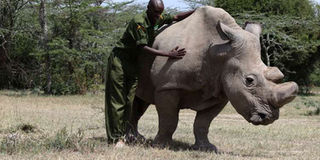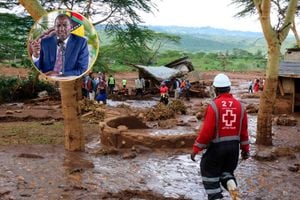Scientists desperate to save white rhino but technology still lacking

Mohammed Doyo tends to the only male surviving northern white rhino by the name Sudan at Ol Pejeta conservancy on June 18, 2015. One of the four surviving endangered northern white rhinos has died at a San Diego zoo in the United States. PHOTO | JOSEPH KANYI
What you need to know:
- After attempts to get them to reproduce naturally failed, conservationists and scientists are looking for alternative ways to prevent them from dying out. But time is clearly not on their side.
- Natural breeding having been ruled out at the Ol Pejeta nature reserve, scientists are looking to science for a solution: futuristic technology that might allow the northern white rhino to make a comeback even after the remaining animals are gone.
- You see, Sudan, 43, and the two females at the expansive Ol Pejeta Conservancy in Nanyuki, Najin, 27, and her calf, Fatu, 13, have been the centre of a whole lot of attention lately. They are three of the only four northern white rhinos remaining in the world.
Worried that the species could soon become extinct, conservationists have tried to have the only remaining male white northern rhino, Sudan, mate with the two females at the Ol Pejeta conservancy in Nanyuki, in vain. Sudan has both reproductive and physical problems that have greatly reduced his ability to produce offspring, while his female companions have their own problems.
Meanwhile, the only other remaining female, which is in a zoo in the United States, it too old to give birth. Conservationists are now considering in vitro fertilization using sperms saved from a rhino that died last year, but the technology for carrying out the risky process, whose success is not guaranteed, is yet to be developed.
As we draw near, he stops eating and is gives us a baleful look, as if ready to charge at us. It takes a massage on the back of his ear by his handler to pacify him. Relaxed, he loosens up and returns to his fodder. Some more rubbing by Mohammed Doyo, his senior caregiver on his hind quarters and belly and soon he is spraying the grounds with jets of ejaculate.
To the ordinary eye — in spite of the his sagging skin and laboured walk telling of his advanced age — this rhino is indeed “well hung”. At least his little show of prowess seems to suggest so, and it takes an explanation of the issues concerning his sexuality by scientists to understand the catastrophe that besets him, and his kind.
You see, Sudan, 43, and the two females at the expansive Ol Pejeta Conservancy in Nanyuki, Najin, 27, and her calf, Fatu, 13, have been the centre of a whole lot of attention lately. They are three of the only four northern white rhinos remaining in the world.
The other is 44-year-old Nola, another female, at the San Diego Zoo in the United States.

Mr Richard Vigne, Ol Pejeta CEO during an interview on June 17, 2015. PHOTO | JOSEPH KANYI
LAST HOPE
At one point Sudan also lived in a zoo, but after being deemed the most sexually virile of the seven existing at the time, they (plus another younger male, Suni, who died in October last year) were put on a plane to Kenya from the Dvur Kralove Zoo in the Czech Republic.
It was the beginning of what has turned out to be a race against time to try and get these animals to mate to ensure the species does not die out.
“They had failed to mate at the zoo. Life in the zoo is not very favourable for sexual reproduction, and in particular, this subspecies seems to have challenges breeding in such settings,” explains the Deputy Manager of Wildlife Conservation at Ol Pejeta, Mr Samuel Mutisya.
“It was with the belief that being in natural surroundings and herd behaviour among their closest cousins, the southern white rhinos, with whom they were put here at the conservancy, would spur mating and, hopefully conception, that they were brought back to Africa,” he adds.
And so the world sat back and waited with bated breath for the three — an ageing male that was captured in the wild in Sudan at the age of three and two females who were born in captivity — to do the job for which they had been put on a plane on a freezing December morning in 2009: make some baby rhinos.
However, even though they did mate eventually, despite dogged efforts by the conservancy’s veterinarians and officials, no conception took place.
“At some point, we thought that conception had, indeed, happened, as hormonal tests on their faecal matter showed some encouraging signs, but with time we realised that it was a false alarm,” adds Mutisya.
It was after further thorough reproductive health check-ups on the animals in January this year that the problem was discovered.
The results suggested that Sudan might not be able to father offspring naturally because, not only is his sperm count low, but the quality is also not good enough. Besides, at 43 he is quite old, and already teetering on the edge of the average life expectancy for rhinos, according to conservationists; white rhinos live up to between 40 and 50 years.
In addition, he has a problem with his hind legs, which makes mounting a female impossible.
Yet Sudan is the last male of the northern white rhino species on whose doddering shoulders the herculean task of ensuring continuity of the species squarely sits after the deaths of 35-year-old Suni at the conservancy in October last year, and of 44-year-old Angalifu two months later at the San Diego Zoo.
EXTINCTION LOOMS
Worse still, the results from the check-ups showed that the two females have their own problems, making motherhood unlikely for either.
An ultrasound showed that Fatu has a uterine condition that makes conception impossible, Ol Pejeta Chief Executive Officer Richard Vigne said, adding that, “Even though it could be treated, that is not an option that is being looked at right now as no risks can be taken at this time.”
Meanwhile, Najin is slouchy because her hind legs are too weak to support her weight and is, therefore, an unlikely candidate for mounting, much less a pregnancy. “It is highly unlikely she will carry the extra weight of a 16-month rhinoceros pregnancy,” Mr Vigne observed.
And Nola in the US is too old to bear calves.
It had been hoped that 31-year-old Nabire at the Dvur Kralove zoo in the Czech Republic could be a mother after an operation to remove ovarian cysts. She had been unable to conceive naturally due to a large number of the growths. However, she died on July 27, apparently after one of the cysts burst. Luckily, her healthy ovary was removed and frozen for future use.
So we are down to four animals whose chances of reproducing naturally are slim as we watch the species threatened with extinction.
There are no known members of the species in the wild where they once occurred: Sudan, Chad, the Central African Republic, Uganda and the Congos. As late as 1960, there were more than 2,000 northern white rhinos remaining.
But widespread poaching decimated the population, such that by 1984, there were only about 15 at the Garamba National Park in the Democratic Republic of Congo. Under a strict regime of protection through the intervention of the World Heritage Committee, the IUCN, the World Wildlife Fund (WWF), the Frankfürt Zoological Society and the Congolese government, the population almost doubled by 1993.
However, an intensive aerial survey of the park in July 2004 reported just 22 animals. And poaching subsequently emptied the park of all its remaining rhinos.
Hopes of remnant populations thought to exist in 2010 in Southern Sudan were dimmed when a survey by conservation organisations found no animals. It is believed they were all killed by poachers due to the volatility of the region, which made it hard for the government and conservationists to control poaching.
Rhino horn is worth $60,000 (Sh6,180,000) on the black market, making it much more expensive than gold.
********

A sign outside an area where Northern white rhinos are confined at Ol Pejeta conservancy in Laikipia county on June 17, 2015. PHOTO | JOSEPH KANYI
IMPENDING DOOM
Endangered species
THE NORTHERN WHITE rhino is heading the way of the western black rhino, which was declared extinct in 2011 by the world’s largest conservation network, the International Union for Conservation of Nature’s (IUCN) Red List of Threatened Species. The rhino, found mainly in Cameroon, was last seen in 2006.
In the 1960s and 1970s, there were about 70,000 black rhinos around the world. About 20,000 of these were estimated to be in Kenya. But poaching reduced the population by up to 98 per cent, dipping the numbers to below 2,500 globally and to less than 400 in Kenya by the 1980s.
But the IUCN warns we are not out of the woods yet, as other rhino species could be headed down the same road if care is not taken. In fact it has placed Javan and Sumatran rhinos on its red list of critically endangered with only 57 and about 100 respectively left in the world.
The IUCN had had monitored the western black rhino subspecies for more than six years and even put it on the red list of threatened species as a “critically endangered” species, in the hope that it would be cared for to increase the numbers.
However, the conservation fight seems to have been lost with the declaration of the Chair of the IUCN Species Survival Commission, Mr Simon Stuart, in 2011 that the sub-species extinct.
He says what worries him is not that this particular species is about to become history, but rather, that there are others heading down this same road, yet all the warnings of the impending problems are not being heeded.
The IUCN points to conservation efforts which have paid off for the southern white rhino subspecies, which have seen populations rise from less than 100 at the end of the 19th century to an estimated wild population of 20,000 today.
Still, the current numbers are said to be 90 per cent lower than three generations ago.
“In the case of the western black rhino and the northern white rhino, the situation could have had very different results if the suggested conservation measures had been implemented,” Mr Stuart, said in a statement.
*******

Conservationists are now considering in vitro fertilization using sperms saved from a rhino that died last year, but the technology for carrying out the risky process, whose success is not guaranteed, is yet to be developed. PHOTO | FILE
Nature has failed, but science can help
WITH THE POSSIBILITY of natural breeding having been ruled out at the Ol Pejeta nature reserve, scientists are looking to science for a solution: futuristic technology that might allow the northern white rhino to make a comeback even after the remaining animals are gone.
In fact, the matter is so sensitive to the world of conservation that a global management committee spearheading the breeding of the northern white rhino has been established to make decisions centrally.
The caregivers, scientists, and conservationists hope that whatever science-aided reproduction methods they come up with will be able to breathe new life into the endangered subspecies.
The group is already considering in-vitro fertilization using Nabire’s saved egg, plus those to be harvested from Najin and Fatu, and sperm from Sudan or some previously saved from Suni.
The plan is to fertilise the egg with the sperm and implant the resultant embryo in a southern white female to serve as a surrogate.
But the appropriate technology to do this is still some way off.
ASSISTED FERTILTY
“As of now, the technology to remove eggs from females and fertilize these eggs in a test tube is inexistent. Protocols and procedures that will govern the processes are only just being developed,” said Mr Vigne.
“It is still not known how long it could take to get all this to work out, and by no means is it guaranteed success. But we feel duty-bound to try and make it happen.
“We are in a race against time to do this before anything happens to the animals,” he adds as he explains the complexity of the process that will go into developing the protocol.
There is the delicate matter of getting the eggs from Najin and Fatu without endangering their lives during the complicated operation, or damaging the subsequent embryo in the intricate process of fusing it with the sperm.
He says that the technique of harvesting eggs from living rhinos will first have to be tried on the subspecies’ closest cousin, the southern white rhino, which exist in good numbers in South Africa and in zoos in Europe. Steps towrds the process, which estimates indicate could cost as much as $1 million, have already began in Europe.
Although this is the only realistic option left for the species, another envisioned solution is inseminating the southern white female with northern white sperm stored around the world. The resultant calf would be a crossbreed, which would then be purified with further conceptions over time. But the problem is that it is not known how viable such an offspring would be for future procreation.
Still, the team has taken a deliberate decision to collect biological materials of reproductive importance from the remaining animals for, among other things, possible tissue culture procedures.
“The tragedy will be if we lose the females, as they are only way to keep the eggs alive for now,” Mr Vigne said.
Ol Pejeta has already preserved Suni’s semen and other tissues collected when he died and is collecting semen from Sudan. The San Diego Zoo has semen from Angalifu and will harvest Nola’s eggs upon her death. The same would happen if Fatu and Najin died.
Every precaution has been taken in the management of these animals to ensure their safety, such that they have special enclosures to which they retire after a day in the open savannah. They are also guarded round the clock, and have been dehorned in an attempt to make them worthless to poachers.
White rhino population figures
Sub species Population
Southern white 20,405
Northern white 4
Black rhino population figures
Sub-species Population
Eastern 799
South western 1,957
South central 2,299
Asian rhino population figures
Greater one-horned
Sumatran Fewer than 100
Javan Fewer than 60
Source: An IUCN report published on December 14, 2014, and the results of a 2012/2013 census for Asian rhino populations.




